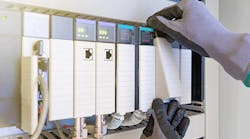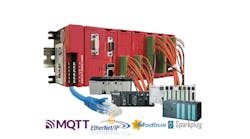With distributed I/O, the control system is designed to be able to distribute data and information to a variety of devices that are on the network. Distributed I/O allows for faster data transfer between the input and output devices. This is because it doesn't rely on a single central computer or controller. Instead, it relies on multiple controllers that are connected to one another via an Ethernet network.
Distributed I/O systems are more scalable than centralized systems, which means they can be used in larger operations with more equipment without slowing down. The benefits of distributed I/O are:
- It increases the reliability because it has a backup if one module fails.
- It reduces the number of cables, which reduces the cost and complexity.
- It reduces downtime.
Also read: How to plan for spare I/O space
A distributed I/O module is used to communicate with other modules on a PLC. The distributed I/O module is the most basic form of input and output in a PLC. It allows you to communicate with the PLC, so that it can read or write data from or to devices such as sensors, motors and lights. It is used to communicate with other modules on a PLC.
A distributed I/O module can be analog or digital. An analog distributed I/O module uses voltage levels to represent information, while a digital one uses binary digits, or bits, to represent information.
With distributed I/O, you will work with IO-Link, a communication protocol that works point to point. This is a communication connection between separate end nodes. IO-Link is bidirectional communication. This communication in manufacturing is used for sensors and actuators. The IO-Link connects the sensors and actuators to a master device that communicates to the controller.
The connection of the master device to the sensors and actuators is made with cables not more than 20 meters or 65 feet long. The master device processes the digital signals and analog values. It also can communicate with the controller using some standard communication protocols such as Profinet, Profibus and Modbus. The master device can allow IO-Link points to be operated in four-port mode.
First mode is the IO-Link mode, which means the point is used for IO-Link communication. The second mode is DI—this is where the port acts as a digital input device. The third mode is the DQ mode, which allows the port to act as a digital output. The fourth mode is deactivated, meaning the ports are not assigned to any other modes.
IO-Link devices have four transmission types—process data, value status, device data and event. Process data is the latest state of a sensor or actuator such as speed. Device data holds detailed information about the device, like serial number, version number, parameters and diagnostic information.
There are three types of input/outputs in a programmable logic controller system. Remote I/O is used when a number of I/Os are clustered together in a place remote from the main PLC. These I/Os are linked to a faraway rack. A network adapter will allow them to interact with the main PLC. Distributed I/O functions similarly to remote I/O. The only difference is the presence of a CPU. With remote I/O design, you may program the entire plant in the central PLC. But this could put a strain on the PLC's total memory, leading to a longer program. Let's wrap up with a look at local I/O. Expansion modules can be attached to the CPU if the CPU assembly needs additional built-in I/Os. This is a good option if your I/Os are restricted to close vicinity to the electrical panel and do not need to travel a long way. Of course, you may connect them to the PLC despite their being outside the distance. Signal loss is possible, and your system wiring may become disordered if you connect a huge number of distant I/Os.
Distributed I/O is a technique that maximizes the number of spare inputs and outputs available to a team. It does this by distributing the I/Os across multiple modules.
This technique has become more popular with the development of the Internet of Things (IoT), which relies on large amounts of data transfer between modules. Also noteworthy:
- Distributed I/O controls process is made easier.
- Controls hardware price is consistent from machine to machine.
- It increases the number of projects accessible to assembly teams.
Building control cabinets takes talent and takes a lot of time to correctly assemble, wire and test. A distributed I/O system can be quickly and easily installed on the machine. Everything is then linked using standard industrial connections, which take less time to install. The manufacturing floor can manage more projects each year because of the speed at which they are put up.





